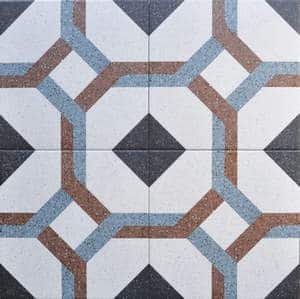Want to know more about decorative tiles? Well, technically, a tile is a piece of hard material (ceramic, stone, glass, or even metal) used to cover surfaces like walls, floors, ceilings, roofs, or tabletops.
What does the word “tile” mean?

The word “tile” derives from the Latin word “tegula,” which is the clay roof tile used over 2000 years ago to cover the roof of a house.
The English word is much more recent, though, from the beginning of the 20th century, referring to the noise over the roof clay tiles that wild cats would make while playing in the night in England.
In reality, tiles are much older than that -some form of tile goes back as 25,000 years!
Where does the tile come from, and why was it invented?
Ceramic tiles as we know them were popular in Ancient Egypt in 4700BC, while glass tiles became popular around 2500BC.
During the Roman and Greek empires, tiles became one of the primary types of decorations.
These tiles were used to cover surfaces and make them more durable while at the same time represent images of events or legends of that time.
Decorative tiles were used as paintings to give life to the artists’ imagination.
A good example is the Roman villas spread throughout Italy, which still today are covered floor to ceiling in marvelous images of kings, battles, landscapes, animals, and myths of the time.
During medieval times, tile production was perfected for the embellishment of noble palaces and monasteries. The clay was precut into pieces, flattened and air-dried, then glazed with lead ore, and finally fired.
Often, the surface of the tiles was coated in gold to create grand statements of power.
Think about the front of the Orvieto Cathedral in Italy, with a large rose window in the center, golden mosaics over the entire facade, and three colossal bronze doors.
During the 16th century, the technique to make encaustic tiles disappeared with the dissolution of the monasteries. It will come back much later, to stay until our present days.
Tiles and the mass production

During Queen Victoria’s reign, decorated wall tiles became of general use and started to be mass-produced and then installed in several public buildings, churches, shops, and even private homes, mainly for their practical use.
Decorated tiles became more commonly used in the 1870s when the beautiful hand-painted glazed tiles from Holland created such a high demand that the English manufacturers started making their own version on a larger scale.
Such a high request for tiles led Herbert Minton, a tile manufacturer, to revamp the technique of encaustic tiles with an additional dust-pressing process, inventing the modern tile manufacturing method.
Encaustic tiles are made by combining a plain clay base with a stamped area, then filled with colored liquid clay, then fired to fuse the different layers together.
With the large availability of these decorative tiles, many different designs were now available in 6 different colors to suit both public buildings like churches and palaces and more modest private homes.
Decorative tiles today

Nowadays, we have brought decorative tile into the future, using prints to reproduce the design of the original encaustic tiles into pure dry-pressed porcelain tiles.
A great example is one of our favorites, the MARRAKESH line of Moroccan look tiles.
We can now appreciate the elegant and classic designs of the Victorian era in our own homes without renouncing the latest technologies that make porcelain tiles the most “maintenance-free” covering option for all our surfaces.
To read more about what tiles are made of, read our blog post dedicated to the difference between Porcelain vs. Ceramics.
